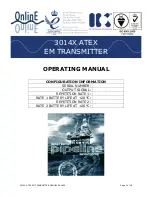
ONLINE ELECTRONICS LTD
3014X ATEX EM TRANSMITTER MANUAL RevB00
Page 12 of 16
3.9.
LITHIUM BATTERY SAFETY
The information given in this section is for reference only. It should not be used in
place of appropriate local regulations or other legal requirements. Online Electronics
Ltd are not responsible for any incident that occurs due to misuse or abuse of their
products or misuse or abuse of lithium cells used by their products.
The batteries used in this transmitter have a very high energy density giving the transmitter a
superior lifetime. However, the same properties which result in a high energy density also
contribute to potential hazards if the energy is released at a fast, uncontrolled rate. With
proper use and handling, ELECTROCHEM cells have demonstrated an excellent safety record in
applications where safety and reliability is of utmost importance.
Because of the recognition of hazards associated with high energy density systems, safety has
been incorporated into the design and manufacture of ELECTROCHEM cells and the Online
Electronics Ltd transmitter. While the transmitter and cells have been designed to be tolerant
to adverse conditions, there are limitations. In particular, the transmitter and cells must be
protected from excessive heat and excessive mechanical abuse. The cells have warnings
printed on their label that cautions against the following conditions:
Short circuit
Charge
Forced over discharge
Excessive heating or incineration
Crush, puncture or disassembly
Rough handling or excessive shock and vibration
Not guarding against these conditions may result in a hot cell that could either vent or explode
at the instant of abuse, or, more typically, the cell shall heat up over a period of time and
subsequently vent or explode when its critical temperature is reached. Problems associated
with hazardous conditions can be greatly reduced by observing the following guidelines:
When handling the transmitter:
Never drop the transmitter. This may damage the cells inside. If dropped, the
cells should be replaced. During operation observe the shock and vibration limits given.
Never store or operate the transmitter outside its operating temperature range.
Always replace all batteries at the same time. Replace with NEW batteries from
the SAME batch. This will help to prevent over discharge of individual cells.
Always observe correct battery polarity when replacing batteries.
When handling loose cells:
Cover all metal work surfaces with an insulating material
The work area should be clean and free of sharp objects that could puncture the
insulating sleeve on each cell
Personnel handling cells should remove all jewellery that could come into contact
with battery terminals
Never stack or scatter loose cells. They should be placed in insulating carrying
trays with individual compartments for each cell.
Cells should be inspected for physical damage, possibly caused by dropping.
Cells with dented cases or terminal caps should be disposed of in a responsible manner.
Measure the Open Circuit Voltage (OCV) of cells. The nominal OCV is 3.9V. An
open circuit voltage of 0.0V is indicative of a blown internal fuse.
The cells must never be disassembled.
REFERENCE:
http://www.electrochemsolutions.com/pdf/Safety_and_Handling_Guide.pdf

































